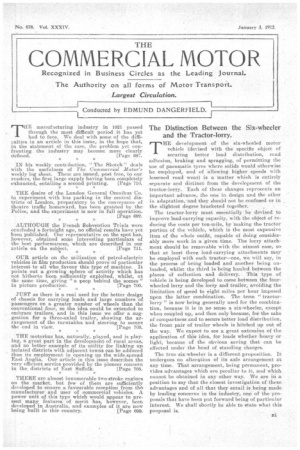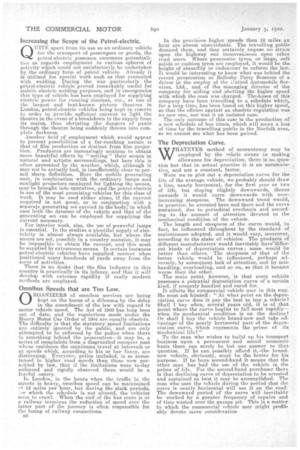The Distinction Between the Six-wheeler and the Tractor-lorry. .
Page 1

Page 2

If you've noticed an error in this article please click here to report it so we can fix it.
THE development of the six-wheeled motor vehicle (devised with the specific object of securing better • load distribution, road adhesion, braking and spragging, of permitting the use of pneumatic tyres where solids would otherwise he employed, and of allowing higher speeds with lessened road wear) is a matter which is entirely separate and distinct from the development of the traotor-Iorry. Each of these changes represents an important advance, the one in design and the other, in adaptation, and they should not be confused or in the slightest degree bracketed together.
The tractor-lorry must essentially he devised to improve load-carrying capacity, with the object of reducing' the costs per ton-mile; by -making the tractor portion of the vehicle, which is the most expensive item of the whole outfit, capable of doing considerably more work in a given time. The lorry attachment should be removable with the utmost ease, so that at least three load-carrying attachments may he employed with each tractor—one, We will say, in the process of being loaded and another being unleaded, whilst the third is being hauled between the places of collection and delivery. This type of vehicle is being developed to come between the fourwheeled lorry and the lorry and trailer, avoiding the limitation of speed to eight miles per hour imposed upon the latter combination. The term "tractorlorry " is now being generally used for the combination, because it is in no sense a six-wheeler, except when coupled up, and then only because, for the sake of compactness and to secure better load distribution, the front pair of trailer wheels is hitched up out of the way. We expect to see a great -extension of the application of this idea, for loads whether heayy or light; because of the obvious saving that -can be effected under the head of standing charges.
The true six-whe..eler is a different proposition. It undergoes no alteration of its axle arrangement at any time. That arrangement, being permanent, provides advantages which are peculiar to it, and which cannot be obtained in any other way. We are in a position to say that the closest investigation of these advantages and of all that they entail is being made by leading concerns in the industry, one of the proposalthat have been put forward being of particular interest. We shall shortly be able to state what this proposal is.
Increasing the Scope of the Petrol-electric.
QUITE apart from its use as an ordinary vehiele for the transport of passengers or goods, the petrol-electric possesses enormous potentialities as regards employment in various sphere S of activity which could not satisfactorily be undertaken by the ordinary form of petrol vehicle. Already it is utilized for special work such as that connected with welding. During the war particularly the petrol-electric vehicle proved remarkably useful for mobile electric welding purposes, and in emergencies this type of vehicle has f.oeen employed for supplying electric power for running cinemas, etc., at one of the largest and best-known picture theatres in London, petrol-electric vehicles being kept in reserve in order to provide sufficient current to light the theatre in the event of a. breakdown in the supply from its mains, thus obviating tho dangers of panic through the theatre being suddenly thrown into complete darkness. Another field of employment which would appear to present possibilities of a far-reaching nature is that of film production as distinct from film projection. Producers are increasingly anxious to obtain more beautiful effects by " setting " their scenes in natural and artistic surroundings, but here this is often prevented by the weather, which, although it may not be actually bad, is insufficiently clear to permit sharp definition. Here the mobile generating unit, in combination with the ordinary lamps and. sunlight projectors employed for lighting the scenes, may be brought into operation, and the petrol-electric is one of the most promising vehicles for this class of work. It may be used either alone, if the current required is not great, or in conjunction With a separake generating set carried in the'body;' in which ease both the dynamo of the vehicle and that of the generating set can be employed for supplying the current necessary. For interior work, also, the use of powerful lamps is essential. In the studios a plentiful supply of electricity is almost always available, but where the scenes are set, possibly in a country mansion, it may be impossible to obtain the current., and this must be supplied by extraneous means. In certain instances petrol-electric vehiele,s have supplied current when positioned many hundreds of yards away from the scene of activities. There is no doubt that the film industry in this country is practically in its infancy, and' that it will develop with extreme rapidity if really modern methods are employed.
Omnibus Speeds that are Too Low.
RGANIZERS of omnibus services are being kept on the horns of a dilemma by the delay
in the amendment of the law with regard to motor vehicle speed. The Act of 1903 has long been out of date, and the regulations made under the Heavy Motor Car Order of 1904 are equally obsolete. The difficulty is that the statutory speed limitations are entirely ignored by the public, and are only attempted to be enforced by the police when there is something behind the proseeution—it may be, a series of complaints from a disgruntled occupier past whose resident* the omnibuses travel at intervals or at speeds which, according to his or her fancy, are distressing. Everyone, police included, is so accustomed to higher road speeds than those now permitted by law, that if the limitations were to-day enforced and rigidly observed there would be a fearful outcry. in London, in the hours when the traffic in the streets is heavy, omnibus speed can be maintained nt 12 miles per hour, but during the slack periods, or which the schedule is not altered, the vehicles
seem to crawl. When the end of the bus route is at a railway terminus the reduction of speed over the latter part Of the journey is often responsible for the losing of railway connections.
In the provinces higher speeds than 12 miles an hour are almost unavoidable. The travelling public demand them, and they certainly impose no strain upon the highway nor inconvenience upon other read users. Where pneumatic tyres, or large, soft solids or cushion tyres are employed, it would be the height of absurdity to endeavour to enforce the law. It would be interesting to know what was. behind tho recent prosecution at Hollesby Petty Sessions of a driver in the employ of the Onited Automobile Services, Ltd., and of the managing director of the company for aiding and abetting the higher speed with which the man was charged. Therbuses of this company have been travelling to a schedule which, for a long time., has been based on this higher speed, so that the offence against an obsolete regulation was no new one, nor was it an isolated case.
The only outcome of this case is the production of a new schedule of bus times, which will mean a loss of time by the travelling public in the Norfolk area, so we cannot see what has been gained.
The Depreciation Curve.
WHATEVER method of accountancy may be employed by the vehcle owner in making allowance for depreciation, there is no question but that in actual practice it is an accumulative and not a constant, factor.
Were we to plot out a depreciation curve for the life of the average vehicle, we probably should draw a line, nearly horizontal, for the first year or two
of life' but sloping slightly downwards, thence onwards it would curve downwards with ever increasing steepness. Tho downward trend would, in practice, be arrested here and there and the curve sustained, due to periodical overhauls and according to the amount of attention devoted to the mechanical condition of the vehicle.
The length and steepness of the curve would, in fact, be influenced throughout by the standard of maintenance adopted, and it would vary, moreover, according to the Make of vehicles. The products of different manufacturers would inevitably have'differ ent "kinds of depreciation curves; some would be better than others. " The steepness of that of the better vehicle would be influenced, perhaps ad. versely, by aubsequenp lank of attention, and by mishandling, overloading, and so on, so that it became worse than the other. . The main point, however, is that every vehicle possesses-a potential depreciation curve of a certain kind, if properly handled and cared for. It affects the commercial vehicle user in this way. He must ask himself: "At what point on the depre ciation curve does it pay the best to buy a vehicle?
Shall I buy when, several years old, it is at that point where the curve begins to fall most rapidly— when its mechanical condition is on the decline? Or shall I buy the vehicle brand-new and take aavantage' of the nearly horizontal part of the depreciation curve, iiThich represents the prime of its mechanical life?"
To the man who wishes to build up his transport business upon a permanent and sound economic basis there can surely be but one answer to that question. If he can possibly afford it, ...the brandnew vehicle, obviously, must be the better for his purpose. If he buys second-hand it means that the other man has had the use of the vehicle in the prime of life. For the second-hand purchaser there
is that declining curve of depreciation to be arrested and sustained as best it may be accomplished. The ma,n who uses the vehicle during the period that the Curve is nearly horizontal will use it on the road.
The. downward period of the curve will inevitably be worked by a greater frequency of repairs and
of time wasted over the garage pit. This is a matter to which the commercial vehicle user might profitably devote more consideration




























